VIRUS UPDATE: Xàbia continues its downward trend with just 15 new cases registered
The infection spread in the Marina Alta has almost halved in two weeks.
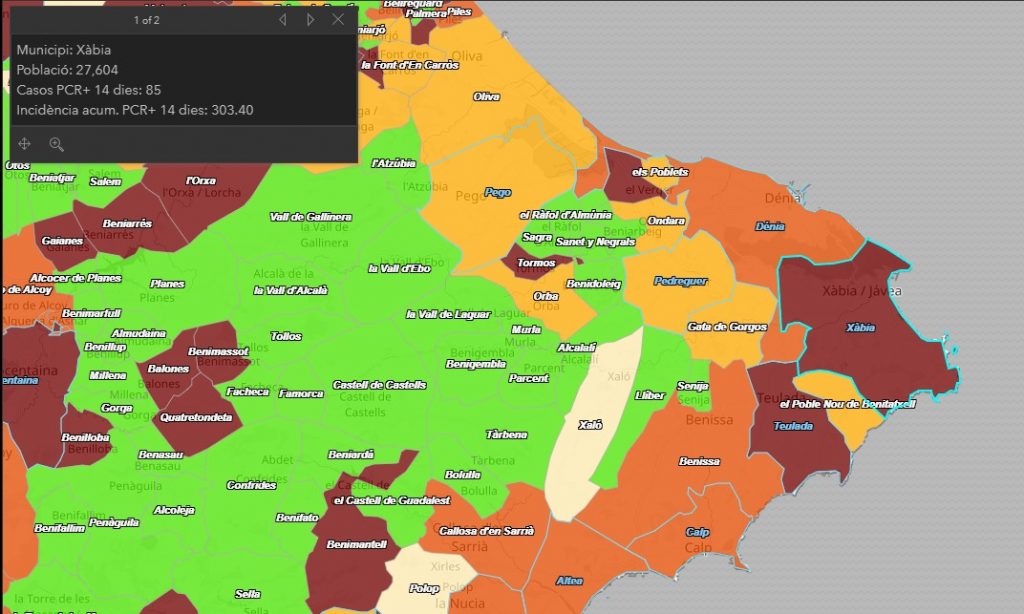
Tuesday 31st August 2021 – Compiled by MIKE SMITH
Xàbia
The total number of positive coronavirus cases detected by PCR test in Xàbia has climbed to 2,293, according to the latest update from the regional health ministry, an increase of 15 since the last update on Friday 27th August and the lowest rise since the end of June.
The municipality’s 14-day IA rate, a measure of the speed at which the virus moves through the population, has dropped to 303.40 cases per 100,000 inhabitants and the town remains in the ‘Extreme Risk’ alert level.
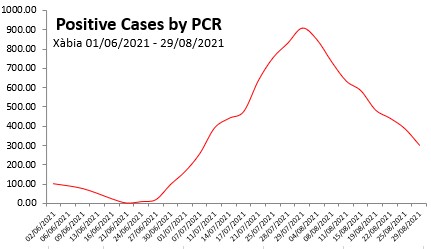
There have been no new deaths in Xàbia since late March and the number remains at 12.
Marina Alta
There have been 355 new positive cases detected by PCR test in the Marina Alta in the past 14 days and the region’s 14-day IA rate has dropped to 208.06 cases per 100,000 inhabitants and it remains in the ‘Extreme Risk’ alert level. The detection of positive cases of COVID-19 in the region has almost halved in two weeks.
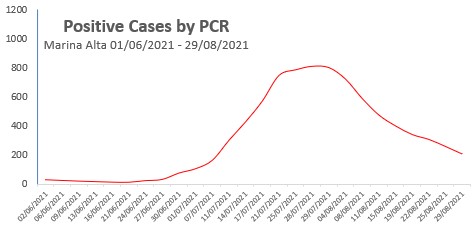
There have been 0 new deaths since the last update and the region’s toll remains at 205.
The total number of positive cases since the pandemic began is now 14,350 since the last update on Friday 27th August, a rise of 76.
- 16 – Calp; Dénia
- 15 – Xàbia
- 8 – Teulada-Moraira
- 5 – Pego
- 4 – Benissa
- 3 – Gata de Gorgos; Pedreguer; el Poble Nou de Benitatxell
- 1 – Benidoleig; Ondara; Orba
Municipalities at EXTREME RISK level
El Vergel; Teulada-Moraira; Tormos; Xàbia.
Municipalities at HIGH RISK level
Benissa; Calp; Dénia.
Municipalities at MEDIUM RISK level
Els Poblets; Gata de Gorgos; Ondara; Orba; Pedreguer; el Poble Nou de Benitatxell; Xaló.
Municipalities at LOW RISK level
Xaló.
Autonomous Regions at NEW NORMAL level
Adsubia; Alcalalí; Beniarbeig; Benidoleig; Benigembla; Benimeli; Castell de Castells; Llíber; Murla; Parcent; el Ràfol d’Almúnia; Sagra; Sanet y Negrals; Senija; la Vall d’Ebo; la Vall de Lagaur; la Vall de Gallinera.
Spain
Spain’s 14-day IA rate is 242.18 cases per 100,000 inhabitants, a drop of more just over 23% in the last week, and a decrease that means that the country drops back down into the High Risk level for the first time since early July.
The Positivity Rate, the measure of how many coronavirus tests return positive, has dropped to 9.43%. A value of 5% or less indicates that transmission of the virus is more or less under control.
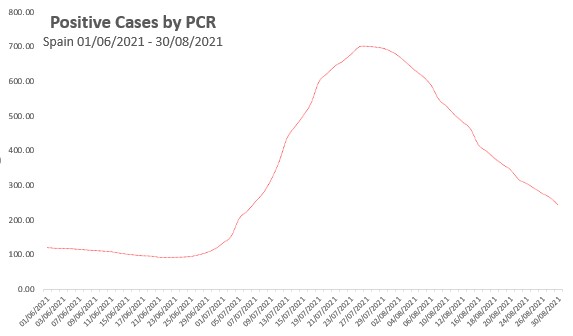
Hospitalizations
According to the latest report from the CCAES, there are 7,114 hospitalized due to COVID-19 across Spain, a drop of almost 24% on two weeks ago, of which 1,652 have been admitted to ICU wards, a drop of almost 14% on two weeks ago. The percentage of beds in general wards occupied by patients suffering from COVID-19 is 6.07% whilst the percentage of beds in ICU wards occupied by COVID-19 patients is 18.04%, both lower than two weeks ago.
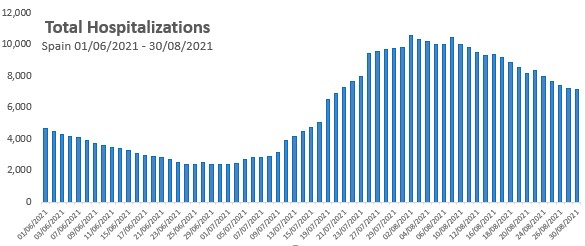
Madrid now leads the way in hospitalizations with 1,545 people currently in hospital due to COVID-19, of which 31.69% have been admitted to ICU wards for extreme cases. Cataluña is just behind, with 1,508 people in hospital, of which 33.74% are in ICU wards, whilst Andalucia has 1,018 people in hospital, 11.08% of which are being cared for in ICU wards.
In the Comunidad Valenciana, 449 people are currently hospitalized, according to the latest CCAES report, with 14.30% of ICU ward capacity occupied by those suffering from the extreme effects of COVID-19.
Deaths
The country has suffered 269 deaths in the past seven days, a rise of just under 12% when compared to two weeks ago. This appears to be the normal progress of the infection spread: positive cases rise, then hospitalizations increase, and finally the number of deaths increase. This can clearly been seen in the three charts given in this summary for Spain.
The national death toll rises to 84,146 since the pandemic began.
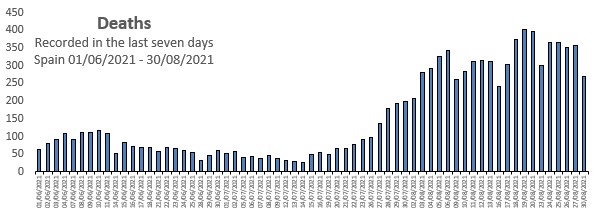
Regional Data
Across Spain, the rise of infections continues to slow with all but one of the 19 autonomous regions have reported IA rates lower than they were two weeks ago. The North African enclave of Ceuta (546.31) is, again, the odd one out with a 13% rise in infections in a fortnight but this has been attributed to the fact that 63 of the 177 new cases diagnosed in the last seven days corresponding to outbreaks in migrant reception centres in the city.
Behind Ceuta, just two regions remains above 400: Extremadura (468.80), and the autonomous city of Melilla (463.96).
At the other end of the scale remains Asturias (94.33) with the Canarias on 150.19.
The Comunidad Valenciana’s rate, currently 197.06, has dropped by 44% in the past two weeks and it remains the autonomous region with the second lowest rate in mainland Spain behind Asturias. All health departments in the region has seen positives cases drop for the first time since mid-March. On average, infection spread has decreased by 37% in two weeks.
Autonomous Regions at EXTREME RISK level
Baleares; Cantabria; Castilla y León; Castilla-La Mancha; Ceuta; Extremadura; Galicia; La Rioja; Madrid; Melilla; País Vasco.
Autonomous Regions at HIGH RISK level
Andalucia; Aragón; Canarias; Cataluña; Comunidad Valenciana; Murcía; Navarra.
Autonomous Regions at MEDIUM RISK level
Asturias.
Autonomous Regions at LOW RISK level
None
Autonomous Regions at NEW NORMAL level
None
The newspaper El Pais has reported that the authorities are struggling to contain illegal outdoor drinking parties, known as ‘botellones’, which have multiplied due to the relaxation of certain coronavirus. Local police forces don’t have the number to control the problem and officers have not only been verbally challenged by the youngsters but also attacked with rocks and bottles. The problem has been particularly bad in Cataluña and the regional health authorities have now warned of a potential ‘sixth wave’ of infections. Police in the País Vasco and Andalusia have also reported coming under attack from youths when trying to break up these gatherings.
How does Spain compare to the rest of Europe?
Top 20 table based on new confirmed COVID-19 cases per 1 million population on August 30th 2021.
- Montenegro (1,003.10) ↑
- Kosovo (977.65) ↓
- United Kingdom (489.62) ↓
- North Macedonia (440.51) ↓
- Republic of Ireland (354.30) ↓
- Serbia (331.75) ↑
- Cyprus (309.20) ↓
- Greece (300.93) ↓
- Switzerland (294.68) ↑
- Albania (279.06) ↑
- France (267.83) ↓
- Estonia (266.59) ↑
- San Marino (252.03) ↑
- Norway (226.27) ↑
- Turkey (221.60) ↓
- Iceland (219.68) ↓
- Bulgaria (217.56) ↑
- Portugal (217.39) ↓
- Lithuania (216.63) ↑
- Slovenia (205.69) ↑
Spain is in the 24th position (161.81) ↓
↑ = infection spread trend rising
↓ = infection spread trend dropping
Source: ourworldindata.org
Vaccination (26.08.21)
Spain has administered 65,444,891 doses of vaccine, which is 91.1% of those which it has already received (71,756,402). A total of 32,811,664 people have completed the recommended course, which is 77.9% of the total of the population which is to be vaccinated (42,119,827) or 69.1% of the total population of Spain.
According to the latest data provided by the health authorities, 94.1% of people aged 40 and over in Spain have received at least one dose, with 91.9% having completed the recommended course.
The Comunidad Valenciana has administered 6,914,324 doses of vaccine, which is 90.7% of the total which it has received (7,620,680). A total of 3,403,774 people have completed the recommended course, which 75.8% of the population which is to be vaccinated (4,488,459) or 67.3% of the total population of the Comunidad Valenciana.
According to the latest data provided by the health authorities, 94.8% of people aged 40 and over in the Comunidad Valenciana have received at least one dose, with 92.7% having completed the recommended course.
How does Spain compare to the rest of Europe?
Top 20 table based on percentage of total population fully vaccinated.
- Malta (80.08%)
- Iceland (76.75%)
- Portugal (73.61%)
- Denmark (71.73%)
- San Marino (70.44%)
- Spain (69.44%)
- Belgium (69.41%)
- Republic of Ireland (67.34%)
- United Kingdom (62.63%)
- Netherlands (62.32%)
- Italy (60.12%)
- Germany (59.77%)
- Cyprus (58.00%)
- France (57.70%)
- Austria (57.39%)
- Hungary (57.16%)
- Luxembourg (55.88%)
- Lithuania (55.44%)
- Greece (55.08%)
- Norway (54.98%)
Source: ourworldindata.org
LINKS
- Actualización nº 451. Enfermedad por el coronavirus (COVID-19). 30.08.2021
- GIV COVID-19 Gestión integral de la vacunación COVID-19
- COVID-19 C. Valenciana: Monitoratge de la situació



